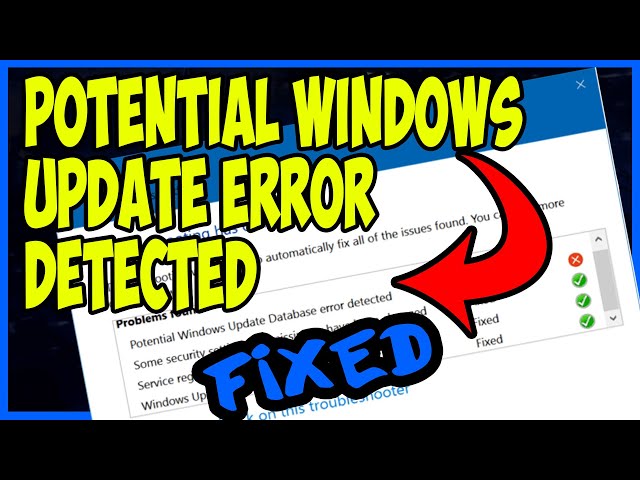Potential Windows Update Error: Troubleshooting and Solutions
In the ever-evolving digital landscape, keeping your Windows operating system up-to-date is crucial for optimal performance and security. Regular Windows updates provide essential patches, bug fixes, and new features. However, the journey isn’t always smooth, and you might encounter potential Windows update errors along the way.
This article aims to be your go-to guide for understanding, troubleshooting, and solving common Windows update errors. We’ll walk you through the process step by step, ensuring that your system stays healthy and up-to-date. Let’s dive in!

Understanding Windows Update Errors
What Are Windows Update Errors and Why Do They Occur?
Before delving into solutions, it’s essential to grasp the nature of Windows update errors. These errors are specific codes or messages that indicate a hiccup in the update process. They can range from mildly inconvenient to potentially disruptive, and understanding why they occur is the first step toward resolving them.
Why Do They Occur? Windows update errors can manifest for various reasons, including:
- Software Conflicts: Sometimes, third-party applications or conflicting system files can disrupt the update process.
- Network Issues: An unstable or slow internet connection can lead to update failures.
- Insufficient Disk Space: Your system needs enough free space to download and install updates.
- Corrupted Update Files: Occasionally, update files can become corrupted, causing issues during installation.
These errors, if left unaddressed, can impact your system’s performance and leave it vulnerable to security threats. That’s why it’s crucial to troubleshoot and resolve them promptly.
Common Windows Update Errors
Identifying Common Windows Update Errors
Let’s take a closer look at some of the most frequently encountered Windows update errors. Recognizing these errors and their symptoms is the first step toward finding a solution. Here are a few of them:
-
Error 0x80070002 – The System Cannot Find The File Specified:
- Symptoms: You may see a message like “Error 0x80070002” while attempting to install updates.
- Possible Causes: This error often occurs when Windows is unable to locate a required update file. It can result from corrupted system files or misconfigured settings.
-
Error 0x80070005 – Access Denied:
- Symptoms: You receive an “Access Denied” message when trying to update Windows.
- Possible Causes: This error typically stems from permission issues. It can happen if your user account doesn’t have the necessary privileges to perform the update.
-
Error 0x8024402F – Windows Update Encountered an Unknown Error:
- Symptoms: Windows Update fails with an “Unknown Error” message.
- Possible Causes: This error often relates to problems with the Windows Update service or network configuration.
Preparing for Troubleshooting
Preparation Is Key: Getting Ready to Tackle Windows Update Errors
Before you embark on troubleshooting Windows update errors, it’s crucial to prepare your system and yourself for the task ahead. Proper preparation can streamline the process and increase your chances of success.
1. Backup Your Data:
- Why is this important? Before making any significant changes to your system, create a backup of your important files and data. This precaution ensures that even if something goes wrong during troubleshooting, your data remains safe.
- How to do it: Use built-in Windows tools or reliable third-party backup software to create a complete system backup or backup specific files and folders.
2. Create a System Restore Point:
- Why is this important? System Restore Points allow you to revert your system to a previous state if troubleshooting causes unexpected issues.
- How to do it: Search for “Create a restore point” in the Windows search bar, then follow the prompts to create a restore point.
3. Check Available Disk Space:
- Why is this important? Windows updates require free space on your hard drive to download and install. Insufficient disk space can lead to update errors.
- How to check it: Open File Explorer, right-click on your system drive (usually C:), and select “Properties” to view available space.
4. Temporarily Disable Third-Party Software:
- Why is this important? Sometimes, third-party antivirus or security software can interfere with the update process. Temporarily disabling them can help identify the root cause of an error.
- How to do it: Locate your antivirus or security software in the system tray, right-click its icon, and select the option to disable or pause protection.
Troubleshooting Steps
Step 1: Windows Update Troubleshooter
The Windows Update Troubleshooter is a built-in tool designed to automatically diagnose and resolve common update-related issues. It’s an excellent starting point for resolving Windows update errors.
How to Run the Windows Update Troubleshooter:
- Press the
Windowskey and type “Troubleshoot settings” in the search bar. Select it from the search results. - Scroll down and find “Windows Update” under “Get up and running.” Click “Run the troubleshooter.”
What It Can Fix:
- The Windows Update Troubleshooter can address various issues, such as detecting and repairing corrupted update files, fixing problems with Windows Update services, and resolving update-related registry issues.
Step 2: Checking Your Internet Connection
A stable and reliable internet connection is crucial for downloading Windows updates. If your connection is intermittent or slow, it can lead to update failures.
How to Troubleshoot Network Issues:
- Restart your modem and router.
- Use a wired Ethernet connection if possible, as it’s generally more stable than Wi-Fi.
- Disable any VPN or proxy settings that might interfere with your connection.
- Run a speed test to ensure your internet connection is sufficient for downloading updates.
Step 3: Clearing Update Cache
The Windows Update cache stores temporary files that can sometimes become corrupted, causing update errors.
How to Clear the Windows Update Cache:
- Press
Windows + Rto open the Run dialog. - Type “services.msc” and press Enter to open the Services window.
- Scroll down and find “Windows Update” in the list.
- Right-click on “Windows Update” and select “Stop.”
- Now, open File Explorer and navigate to
C:\Windows\SoftwareDistribution. - Delete all the files and folders inside the SoftwareDistribution folder.
- Return to the Services window, right-click on “Windows Update” again, and select “Start.”
What It Can Fix:
- Clearing the update cache can resolve issues related to corrupted or stuck update downloads.
Advanced Solutions
Step 4: Reviewing System Files with SFC
The System File Checker (SFC) is a powerful Windows utility that can help repair corrupted or missing system files, which are often responsible for Windows update errors.
How to Run SFC:
- Press
Windows + Xand select “Windows Terminal (Admin)” or “Command Prompt (Admin)”. - Type “sfc /scannow” and press Enter.
- Let the scan complete; this may take some time.
- Follow any on-screen prompts to repair files if needed.
What It Can Repair:
- SFC can fix corrupted system files, which might be causing update errors.
Step 5: Manually Downloading Updates
In some cases, manually downloading and installing updates can bypass issues encountered during automatic updates.
How to Manually Download and Install Updates:
- Visit the Microsoft Update Catalog website (search for it in your preferred search engine).
- Search for the specific update by its KB number or description.
- Download the update package compatible with your system architecture (32-bit or 64-bit).
- Double-click the downloaded file to install the update.
When to Consider Advanced Solutions:
- If the previous steps haven’t resolved your Windows update error, these advanced solutions can help tackle more complex issues.
Avoiding Future Update Errors
Proactive Measures to Prevent Future Windows Update Errors
Once you’ve successfully resolved a Windows update error, it’s essential to take proactive steps to avoid encountering similar issues in the future. Here are some strategies to keep your system running smoothly:
1. Regular Maintenance:
- Why is this important? Regularly maintaining your computer, such as cleaning out temporary files, optimizing storage, and updating drivers, can prevent underlying issues that may trigger update errors.
- How to do it: Consider using system maintenance tools or third-party utilities to automate routine tasks.
2. Setting Up Automatic Updates:
- Why is this important? Enabling automatic updates ensures that your system receives critical patches and fixes as soon as they’re available, reducing the chances of encountering known issues.
- How to do it: Go to “Settings” > “Update & Security” > “Windows Update” and configure your update settings to “Automatic.”
3. Staying Informed:
- Why is this important? Staying informed about known Windows update issues and their resolutions can help you proactively address potential errors.
- How to do it: Follow official Microsoft blogs and support channels, join tech forums, or subscribe to newsletters that provide updates on Windows-related issues.
By implementing these proactive measures, you can significantly reduce the likelihood of facing Windows update errors in the future and ensure that your system remains secure and up-to-date.
Conclusion
Wrapping Up: A Well-Updated and Error-Free Windows
In the ever-evolving digital landscape, keeping your Windows operating system up-to-date is not just a matter of convenience but a fundamental step in ensuring the security and performance of your computer. While potential Windows update errors can be frustrating, they are not insurmountable.
By understanding the nature of these errors and following the troubleshooting steps outlined in this guide, you can effectively address and resolve Windows update errors, restoring your system to its full potential.
Remember that preparation, regular maintenance, and staying informed about known issues are key to avoiding future update errors. With these practices in place, you’ll enjoy a stable and reliable Windows experience.
Additional Resources
For Further Assistance and Information
For additional resources, support, and more in-depth guidance on Windows update issues, consider exploring the following:
- Microsoft Support: Official Microsoft support website for Windows-related queries and solutions.
- Windows Update Catalog: Access specific update files for manual installation.



